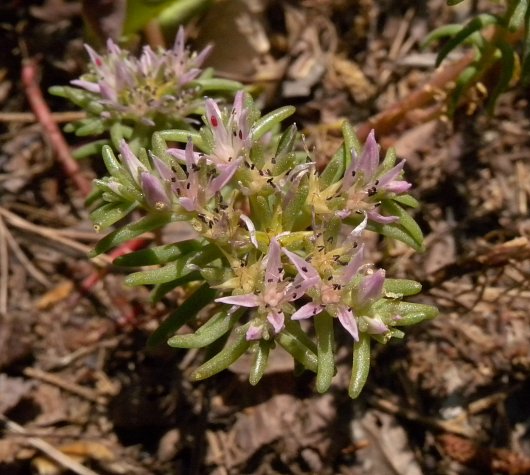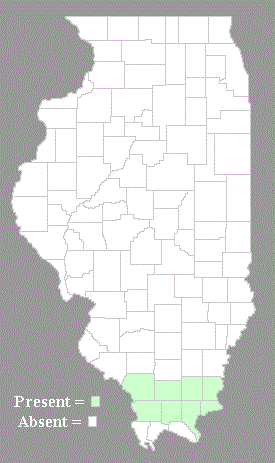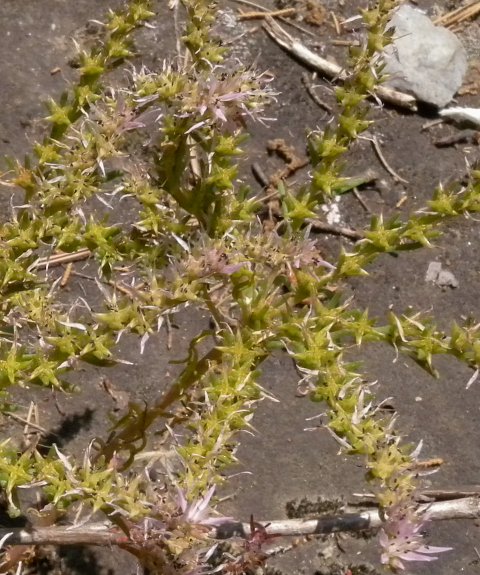
Each stem terminates in a cyme of flowers up to 6" across. Each cyme has 3-7 horizontal branches that are spaced widely apart; the flowers are densely arranged along the upper sides of these branches (typically 10-40 flowers per branch). The flowers are sessile or nearly sessile (on pedicels less than 1 mm. in length). Each flower spans about ½" across, consisting of 4 pink petals (rarely white), 4 pale green sepals, a cluster of 4 pistils, and 8 stamens. The petals and sepals are linear-lanceolate in shape; the petals are about twice the length of the sepals. The narrowly ovoid pistils are light pink (less often white) during the blooming period; each pistil has a single style. The anthers are initially dark red, but they turn black shortly afterwards. Among the flowers, there are bracts that resemble the leaves, except they
 are about
one-half the size of the latter. The blooming period occurs during late
spring to early summer, lasting about 1 month. Afterwards, the flowers
are replaced by clusters of 4 spreading follicles; these follicles are
about ¼" long, narrowly ovoid in shape, and prominently beaked.
Immature follicles are pale green, but at maturity they turn brown.
Eventually, each follicle splits open along one side to release
numerous seeds. The root system is fibrous. This wildflower spreads by
reseeding itself. At favorable sites, it often forms colonies of plants.
are about
one-half the size of the latter. The blooming period occurs during late
spring to early summer, lasting about 1 month. Afterwards, the flowers
are replaced by clusters of 4 spreading follicles; these follicles are
about ¼" long, narrowly ovoid in shape, and prominently beaked.
Immature follicles are pale green, but at maturity they turn brown.
Eventually, each follicle splits open along one side to release
numerous seeds. The root system is fibrous. This wildflower spreads by
reseeding itself. At favorable sites, it often forms colonies of plants.Cultivation: The preference is full sun, dry conditions, and thin rocky soil. Partial sun is tolerated, although there will be a greater tendency for individual plants to sprawl in the direction of greater light. Seeds typically germinate in the fall, allowing young plants to overwinter in a dormant state. Most growth and development occur during the spring. The leaves wither away during the hot weather of summer as individual plants die down. This plant has a crassula acid metabolism (CAM) that enables it to survive in xeric conditions. Like other sedums (Sedum spp.), Widow's Cross can be cultivated in sunny rock gardens.
Range & Habitat: The native Widow's Cross occurs in southern Illinois, where it is uncommon. Illinois lies along the northern range of this species. Habitats include rocky cliffs, exposed rocky ledges, and rocky glades, particularly in areas where there is exposed flat bedrock. The underlying bedrock in these habitats consists of sandstone, limestone, or chert. Widow's Cross is a highly specialized plant that is found in high quality natural areas.
Faunal Associations: Very little is known about floral-faunal relationships for this species. Generally, the flowers of sedums (Sedum spp.) are cross-pollinated by small bees (Andrena spp., etc.) and probably other insects. Both nectar and pollen are available as floral rewards to such visitors. In areas where Widow's Cross and other sedums are cultivated (especially nurseries and greenhouses), they may be attacked by Aphis sedi (Sedum Aphid). This aphid was introduced into North America from Eurasia.
Photographic Location: A rocky ledge in southern Illinois.

Comments: Other common names for Widow's Cross (Sedum pulchellum) are Limestone Stonecrop and Rock Stonecrop. Widow's Cross is normally an attractive little plant with pink flowers. It is one of only a few native Sedum spp. that are found in the rocky hills of southern Illinois and the surrounding area. Several species of cultivated sedums from Eurasia occasionally escape and naturalize in open disturbed habitats, but they usually don't persist (with the exception of Sedum acre). Widow's Cross can be distinguished from these other species by its pink 4-petaled flowers, widely spreading branches of its inflorescence, and small linear leaves that are nearly terete. Other sedums often have white or yellow flowers, flowers with 5 petals, inflorescences with ascending branches, or leaves that are more flattened and wide than those of Widow's Cross.